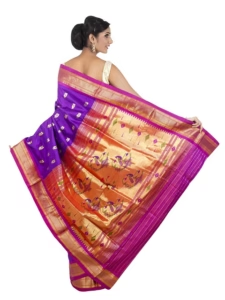
The Paithani saree stands as a radiant jewel in the crown of Indian ethnic wear. Revered for its lustrous silk, rich zari borders, and intricate motifs, the Paithani is not just a garment—it is a living legacy that interweaves ancient tradition with timeless elegance. For fashion enthusiasts and cultural connoisseurs alike, owning a Paithani saree is akin to owning a piece of Indian heritage. Let’s journey through its fascinating history, unique making process, and enduring importance to understand why the Paithani saree continues to be celebrated across generations.
The Glorious History of Paithani Sarees
Originating from the ancient town of Paithan, situated on the banks of the Godavari River in Maharashtra, the Paithani saree traces its roots back over 2,000 years. This exquisite weave was patronized by rulers of the Satavahana dynasty and was considered a symbol of prestige among the royals. In ancient times, Paithani sarees were traded extensively by merchants travelling the famous silk routes, making them prized possessions across India and other parts of Asia.
During the Peshwa era, the artform received royal patronage, further elevating its status. The Paithani saree became an integral part of Maharashtrian bridal trousseaus and festive celebrations. Even today, it is passed down as a family heirloom, cherished for both its material value and emotional significance.
Unique Weaving Techniques and Craftsmanship
- A genuine Paithani saree is distinguished by its handwoven finesse and intricate patterns. The making of a single Paithani saree is a labour-intensive process, often taking several months to complete. Master weavers employ traditional techniques passed down through generations, using high-quality pure silk threads and zari (gold or silver metallic threads) sourced from select regions.
Key highlights of the Paithani weaving process:
- Handloom Tradition: Each saree is woven entirely by hand on wooden looms, preserving the authenticity of the craft.
- Resist Dyeing: The silk yarn is dyed in vibrant colors using natural and chemical dyes, providing the saree its rich and long-lasting hues.
- Brocade Borders and Pallu: The decorative border and pallu (the end piece) are adorned with intricate motifs, commonly featuring peacocks, lotuses, vines, and geometric designs.
- Unique Motifs: The “Mor” (peacock), “Bangadi Mor” (peacock in bangle), “Asawali” (floral), and “Rui Phul” (cotton flower) are classic motifs, each reflecting specific symbolism and artistry.
The Importance and Cultural Significance of Paithani
Paithani sarees are treasured not just for their exquisite beauty but also for their deep cultural resonance. They represent centuries of Maharashtrian tradition and exemplify the state’s rich artisanal legacy.
Why Paithani sarees are important:
- Symbol of Status and Affluence: Traditionally worn by queens and aristocrats, Paithani sarees are still considered a luxury item—often gifted during weddings, festivals, and milestone celebrations.
- Bridal Essential: In Maharashtrian weddings, a Paithani saree is an indispensable part of the bridal trousseau. It signifies the bride’s connection to her heritage and her family’s blessings.
- Artisanal Livelihood: The demand for Paithani sarees sustains the livelihoods of skilled handloom weavers in Paithan and Yeola, helping preserve this ancient craft in the era of machine-made textiles.
- Cherished Heirloom: Passed down from mother to daughter, each Paithani tells a story, carrying with it memories, blessings, and cultural pride.
Trends and Modern Adaptations
While rooted in tradition, Paithani sarees are evolving with changing times. Contemporary designers blend classic motifs with modern silhouettes, making these sarees popular among younger generations. Today, one can find Paithani-inspired lehengas, dupattas, and even stoles—ensuring the age-old artform remains relevant and stylish.
Additionally, the color palette has expanded beyond royal purples and rich greens to include trendy pastel shades and novel patterns, making it easier to match individual tastes and preferences.
How to Identify an Authentic Paithani Saree?
With rising popularity, fake and machine-made imitations abound. To ensure authenticity:
- Check the Weave: Real Paithani sarees boast identical patterns on both sides.
- Feel the Material: Original Paithani is made from pure silk and real zari, imparting a soft, luxurious, and slightly heavy feel.
- Look for Classic Motifs: Iconic handwoven designs and sharp, clear motifs signal an authentic weave.
Caring for Your Paithani Saree
Preserve the lustre and beauty of your Paithani by storing it in a muslin cloth, away from direct sunlight and moisture. Dry clean it occasionally and avoid spraying perfumes directly on the fabric.
In summary, a Paithani saree is not just an attire—it is an artistic masterpiece, a symbol of timeless grace, and a priceless heirloom. Whether you are a bride, a saree enthusiast, or someone looking to invest in Indian ethnic luxury, a genuine Paithani saree will add unparalleled elegance and cultural depth to your collection. Experience the allure of tradition reimagined—embrace the magic of Paithani sarees and celebrate India’s glorious textile heritage.
